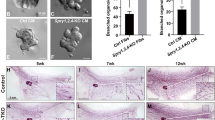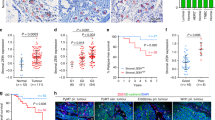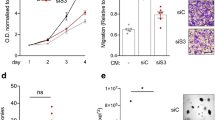Abstract
Fibroblasts within the mammary tumor microenvironment are active participants in carcinogenesis mediating both tumor initiation and progression. Our group has previously demonstrated that genetic loss of phosphatase and tensin homolog (PTEN) in mammary fibroblasts induces an oncogenic secretome that remodels the extracellular milieu accelerating ErbB2-driven mammary tumor progression. While these prior studies highlighted a tumor suppressive role for stromal PTEN, how the adjacent normal epithelium transforms in response to PTEN loss was not previously addressed. To identify these early events, we have evaluated both phenotypic and genetic changes within the pre-neoplastic mammary epithelium of mice with and without stromal PTEN expression. We report that fibroblast-specific PTEN deletion greatly restricts mammary ductal elongation and induces aberrant alveolar side-branching. These mice concomitantly exhibit an expansion of the mammary epithelial stem cell (MaSC) enriched basal/myoepithelial population and an increase in in vitro stem cell activity. Further analysis revealed that NOTCH signaling, specifically through NOTCH3, is diminished in these cells. Mechanistically, JAGGED-1, a transmembrane ligand for the NOTCH receptor, is downregulated in the PTEN-null fibroblasts leading to a loss in the paracrine activation of NOTCH signaling from the surrounding stroma. Reintroduction of JAGGED-1 expression within the PTEN-null fibroblasts was sufficient to abrogate the observed increase in colony forming activity implying a direct role for stromal JAGGED-1 in regulation of MaSC properties. Importantly, breast cancer patients whose tumors express both low stromal JAG1 and low stromal PTEN exhibit a shorter time to recurrence than those whose tumors express low levels of either alone suggesting similar stromal signaling in advanced disease. Combined, these results unveil a novel stromal PTEN-to-JAGGED-1 axis in maintaining the MaSC niche, and subsequently inhibiting breast cancer initiation and disease progression.
This is a preview of subscription content, access via your institution
Access options
Subscribe to this journal
Receive 50 print issues and online access
$259.00 per year
only $5.18 per issue
Buy this article
- Purchase on Springer Link
- Instant access to full article PDF
Prices may be subject to local taxes which are calculated during checkout







Similar content being viewed by others
References
Bhowmick NA, Neilson EG, Moses HL . Stromal fibroblasts in cancer initiation and progression. Nature 2004; 432: 332–337.
Parsonage G, Filer AD, Haworth O, Nash GB, Rainger GE, Salmon M et al. A stromal address code defined by fibroblasts. Trends Immunol 2004; 26: 150–156.
Tomasek JJ, Gabbiani G, Hinz B, Chaponnier C, Brown RA . Myofibroblasts and mechano-regulation of connective tissue remodelling. Nat Rev Mol Cell Biol 2002; 3: 349–363.
Kalluri R, Zeisberg M . Fibroblasts in cancer. Nat Rev Cancer 2006; 6: 392–401.
Mueller MM, Fusenig NE . Friends or foes - bipolar effects of the tumour stroma in cancer. Nat Rev Cancer 2004; 4: 839–849.
Trimboli AJ, Fukino K, de Bruin A, Wei G, Shen L, Tanner SM et al. Direct evidence for epithelial-mesenchymal transitions in breast cancer. Cancer Res 2008; 68: 937–945.
Trimboli AJ, Cantemir-Stone CZ, Li F, Wallace JA, Merchant A, Creasap N et al. Pten in stromal fibroblasts suppresses mammary epithelial tumours. Nature 2009; 461: 1084–1091.
Bocker W, Moll R, Poremba C, Holland R, Van Diest PJ, Dervan P et al. Common adult stem cells in the human breast give rise to glandular and myoepithelial cell lineages: a new cell biological concept. Lab Invest 2002; 82: 737–746.
Dontu G, Al-Hajj M, Abdallah WM, Clarke MF, Wicha MS . Stem cells in normal breast development and breast cancer. Cell Prolif 2003; 36 (Suppl 1): 59–72.
Clarke RB, Spence K, Anderson E, Howell A, Okano H, Potten CS . A putative human breast stem cell population is enriched for steroid receptor-positive cells. Dev Biol 2005; 277: 443–456.
Stingl J, Eirew P, Ricketson I, Shackleton M, Vaillant F, Choi D et al. Purification and unique properties of mammary epithelial stem cells. Nature 2006; 439: 993–997.
Vaillant F, Asselin-Labat ML, Shackleton M, Lindeman GJ, Visvader JE . The emerging picture of the mouse mammary stem cell. Stem Cell Rev 2007; 3: 114–123.
Rios AC, Fu NY, Lindeman GJ, Visvader JE . In situ identification of bipotent stem cells in the mammary gland. Nature 2014; 506: 322–327.
Richert MM, Schwertfeger KL, Ryder JW, Anderson SM . An atlas of mouse mammary gland development. J Mammary Gland Biol Neoplasia 2000; 5: 227–241.
Wiseman BS, Werb Z . Stromal effects on mammary gland development and breast cancer. Science 2002; 296: 1046–1049.
Bronisz A, Godlewski J, Wallace JA, Merchant AS, Nowicki MO, Mathsyaraja H et al. Reprogramming of the tumour microenvironment by stromal PTEN-regulated miR-320. Nat Cell Biol 2012; 14: 159–167.
Boquest AC, Shahdadfar A, Fronsdal K, Sigurjonsson O, Tunheim SH, Collas P et al. Isolation and transcription profiling of purified uncultured human stromal stem cells: alteration of gene expression after in vitro cell culture. Mol Biol Cell 2005; 16: 1131–1141.
Lim E, Vaillant F, Wu D, Forrest NC, Pal B, Hart AH et al. Aberrant luminal progenitors as the candidate target population for basal tumor development in BRCA1 mutation carriers. Nat Med 2009; 15: 907–913.
Kessenbrock K, Wang CY, Werb Z . Matrix metalloproteinases in stem cell regulation and cancer. Matrix Biol 2015; 44-46: 184–190.
Plaks V, Kong N, Werb Z . The cancer stem cell niche: how essential is the niche in regulating stemness of tumor cells? Cell Stem Cell 2015; 16: 225–238.
Polyak K, Kalluri R . The role of the microenvironment in mammary gland development and cancer. Cold Spring Harb Perspect Biol 2010; 2: a003244.
Visvader JE . Keeping abreast of the mammary epithelial hierarchy and breast tumorigenesis. Genes Dev 2009; 23: 2563–2577.
Shackleton M, Vaillant F, Simpson KJ, Stingl J, Smyth GK, Asselin-Labat ML et al. Generation of a functional mammary gland from a single stem cell. Nature 2006; 439: 84–88.
Bouras T, Pal B, Vaillant F, Harburg G, Asselin-Labat ML, Oakes SR et al. Notch signaling regulates mammary stem cell function and luminal cell-fate commitment. Cell Stem Cell 2008; 3: 429–441.
Chiba S . Notch signaling in stem cell systems. Stem Cells 2006; 24: 2437–2447.
Lobry C, Oh P, Mansour MR, Look AT, Aifantis I . Notch signaling: switching an oncogene to a tumor suppressor. Blood 2014; 123: 2451–2459.
Finak G, Bertos N, Pepin F, Sadekova S, Souleimanova M, Zhao H et al. Stromal gene expression predicts clinical outcome in breast cancer. Nat Med 2008; 14: 518–527.
Bissell MJ, Rizki A, Mian IS . Tissue architecture: the ultimate regulator of breast epithelial function. Curr Opin Cell Biol 2003; 15: 753–762.
Radisky DC, Bissell MJ . Cancer. Respect thy neighbor!. Science 2004; 303: 775–777.
Tlsty TD, Hein PW . Know thy neighbor: stromal cells can contribute oncogenic signals. Curr Opin Genet Dev 2001; 11: 54–59.
Ha HY, Moon HB, Nam MS, Lee JW, Ryoo ZY, Lee TH et al. Overexpression of membrane-type matrix metalloproteinase-1 gene induces mammary gland abnormalities and adenocarcinoma in transgenic mice. Cancer Res 2001; 61: 984–990.
Sternlicht MD, Lochter A, Sympson CJ, Huey B, Rougier JP, Gray JW et al. The stromal proteinase MMP3/stromelysin-1 promotes mammary carcinogenesis. Cell 1999; 98: 137–146.
Vaillant F, Asselin-Labat ML, Shackleton M, Forrest NC, Lindeman GJ, Visvader JE . The mammary progenitor marker CD61/beta3 integrin identifies cancer stem cells in mouse models of mammary tumorigenesis. Cancer Res 2008; 68: 7711–7717.
Fuchs E, Tumbar T, Guasch G . Socializing with the neighbors: stem cells and their niche. Cell 2004; 116: 769–778.
Ohlstein B, Kai T, Decotto E, Spradling A . The stem cell niche: theme and variations. Curr Opin Cell Biol 2004; 16: 693–699.
Jeselsohn R, Brown NE, Arendt L, Klebba I, Hu MG, Kuperwasser C et al. Cyclin D1 kinase activity is required for the self-renewal of mammary stem and progenitor cells that are targets of MMTV-ErbB2 tumorigenesis. Cancer Cell 2010; 17: 65–76.
Liu JC, Voisin V, Bader GD, Deng T, Pusztai L, Symmans WF et al. Seventeen-gene signature from enriched Her2/Neu mammary tumor-initiating cells predicts clinical outcome for human HER2+:ERalpha- breast cancer. Proc Natl Acad Sci USA 2012; 109: 5832–5837.
Forster N, Saladi SV, van Bragt M, Sfondouris ME, Jones FE, Li Z et al. Basal cell signaling by p63 controls luminal progenitor function and lactation via NRG1. Dev Cell 2014; 28: 147–160.
Liu JC, Deng T, Lehal RS, Kim J, Zacksenhaus E . Identification of tumorsphere- and tumor-initiating cells in HER2/Neu-induced mammary tumors. Cancer Res 2007; 67: 8671–8681.
Artavanis-Tsakonas S, Rand MD, Lake RJ . Notch signaling: cell fate control and signal integration in development. Science 1999; 284: 770–776.
Callahan R, Egan SE . Notch signaling in mammary development and oncogenesis. J mammary Gland Biol Neoplasia 2004; 9: 145–163.
Dontu G, Jackson KW, McNicholas E, Kawamura MJ, Abdallah WM, Wicha MS . Role of Notch signaling in cell-fate determination of human mammary stem/progenitor cells. Breast Cancer Res 2004; 6: R605–R615.
Reedijk M, Odorcic S, Chang L, Zhang H, Miller N, McCready DR et al. High-level coexpression of JAG1 and NOTCH1 is observed in human breast cancer and is associated with poor overall survival. Cancer Res 2005; 65: 8530–8537.
Robinson GW . Using notches to track mammary epithelial cell homeostasis. Cell Stem Cell 2008; 3: 359–360.
Xu K, Usary J, Kousis PC, Prat A, Wang DY, Adams JR et al. Lunatic fringe deficiency cooperates with the Met/Caveolin gene amplicon to induce basal-like breast cancer. Cancer Cell 2012; 21: 626–641.
Patel PH, Dutta D, Edgar BA . Niche appropriation by Drosophila intestinal stem cell tumours. Nat Cell Biol 2015; 17: 1182–1192.
Ghiabi P, Jiang J, Pasquier J, Maleki M, Abu-Kaoud N, Halabi N et al. Breast cancer cells promote a notch-dependent mesenchymal phenotype in endothelial cells participating to a pro-tumoral niche. J Transl Med 2015; 13: 27.
Ghiabi P, Jiang J, Pasquier J, Maleki M, Abu-Kaoud N, Rafii S et al. Endothelial cells provide a notch-dependent pro-tumoral niche for enhancing breast cancer survival, stemness and pro-metastatic properties. PloS One 2014; 9: e112424.
Qiu M, Peng Q, Jiang I, Carroll C, Han G, Rymer I et al. Specific inhibition of Notch1 signaling enhances the antitumor efficacy of chemotherapy in triple negative breast cancer through reduction of cancer stem cells. Cancer Lett 2013; 328: 261–270.
Xing F, Kobayashi A, Okuda H, Watabe M, Pai SK, Pandey PR et al. Reactive astrocytes promote the metastatic growth of breast cancer stem-like cells by activating Notch signalling in brain. EMBO Mol Med 2013; 5: 384–396.
Xing F, Okuda H, Watabe M, Kobayashi A, Pai SK, Liu W et al. Hypoxia-induced Jagged2 promotes breast cancer metastasis and self-renewal of cancer stem-like cells. Oncogene 2011; 30: 4075–4086.
Yamamoto M, Taguchi Y, Ito-Kureha T, Semba K, Yamaguchi N, Inoue J . NF-kappaB non-cell-autonomously regulates cancer stem cell populations in the basal-like breast cancer subtype. Nat Commun 2013; 4: 2299.
Muller WJ, Sinn E, Pattengale PK, Wallace R, Leder P . Single-step induction of mammary adenocarcinoma in transgenic mice bearing the activated c-neu oncogene. Cell 1988; 54: 105–115.
Soule HD, McGrath CM . A simplified method for passage and long-term growth of human mammary epithelial cells. In Vitro Cell Dev Biol 1986; 22: 6–12.
Bernardo GM, Lozada KL, Miedler JD, Harburg G, Hewitt SC, Mosley JD et al. FOXA1 is an essential determinant of ERalpha expression and mammary ductal morphogenesis. Development 2010; 137: 2045–2054.
Lo PK, Kanojia D, Liu X, Singh UP, Berger FG, Wang Q et al. CD49f and CD61 identify Her2/neu-induced mammary tumor-initiating cells that are potentially derived from luminal progenitors and maintained by the integrin-TGFbeta signaling. Oncogene 2012; 31: 2614–2626.
Abramoff MD, Magelhaes PJ, Ram SJ . Image processing with ImageJ. Biophoton Int 2004; 11: 36–42.
Dontu G, Abdallah WM, Foley JM, Jackson KW, Clarke MF, Kawamura MJ et al. In vitro propagation and transcriptional profiling of human mammary stem/progenitor cells. Genes Dev 2003; 17: 1253–1270.
Acknowledgements
We thank Jason Bice and Daphne Bryant (Solid Tumor Biology Program-Histology Core), Bryan McElwain and Katrina Miller (OSUCCC-Analytic Cytometry) and Sarah Warner (OSUCCC-Genomics) for technical support. This study was supported by the NIH (PO1CA097189, MCO and GL), the Department of Defense (W81XWH-14-1-0040, GMS) and the Pelotonia Fellowship Program (SB and GMS).
Author information
Authors and Affiliations
Corresponding authors
Ethics declarations
Competing interests
The authors declare no conflict of interest.
Any opinions, findings and conclusions expressed in this material are those of the author(s) and do not necessarily reflect those of the Pelotonia Fellowship Program.
Additional information
Supplementary Information accompanies this paper on the Oncogene website
Supplementary information
Rights and permissions
About this article
Cite this article
Sizemore, G., Balakrishnan, S., Hammer, A. et al. Stromal PTEN inhibits the expansion of mammary epithelial stem cells through Jagged-1. Oncogene 36, 2297–2308 (2017). https://doi.org/10.1038/onc.2016.383
Received:
Revised:
Accepted:
Published:
Issue Date:
DOI: https://doi.org/10.1038/onc.2016.383
This article is cited by
-
The role of stromal cells in epithelial–mesenchymal plasticity and its therapeutic potential
Discover Oncology (2024)
-
Macrophages maintain mammary stem cell activity and mammary homeostasis via TNF-α-PI3K-Cdk1/Cyclin B1 axis
npj Regenerative Medicine (2023)
-
Notch3 inhibits cell proliferation and tumorigenesis and predicts better prognosis in breast cancer through transactivating PTEN
Cell Death & Disease (2021)
-
Two Sides of the Same Coin: The Role of Developmental pathways and pluripotency factors in normal mammary stem cells and breast cancer metastasis
Journal of Mammary Gland Biology and Neoplasia (2020)
-
Abrupt involution induces inflammation, estrogenic signaling, and hyperplasia linking lack of breastfeeding with increased risk of breast cancer
Breast Cancer Research (2019)



